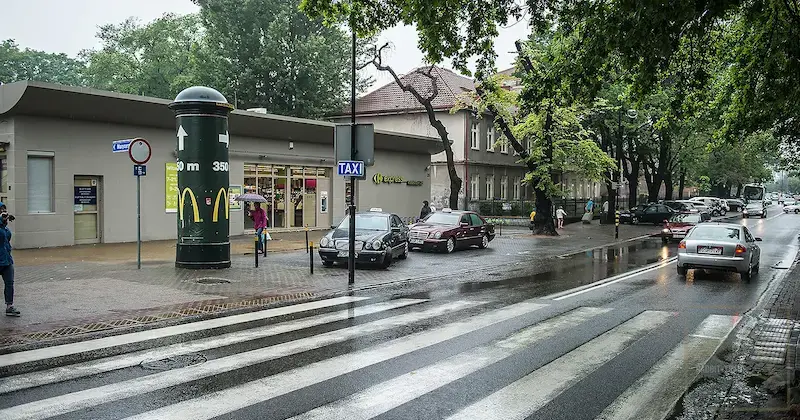Taxi and parking sign - What are the rules and regulations?
- Damian Brzeski

- Mar 25
- 6 min read
Taxi ranks are an important element of road traffic organization, ensuring the comfort of passengers and facilitating the work of taxi drivers.
However, not all road users are aware of the rules regarding taxi parking, what the taxi sign means and what the consequences are for failing to comply with the regulations.
In this article, we will take a closer look at taxi rank signage, changes to regulations and fines for unauthorized parking.

What does a taxi rank signage look like?
Each taxi rank means a specially designated place where only vehicles with a taxi license are allowed to park.
These places are marked with specific road signs that clearly indicate their beginning and end.
In 2022, changes were introduced to the order of marking stops, which aimed to improve the intuitiveness of these regulations.
Sign D-19 – the beginning of the taxi rank
Sign D-19 , the beginning of the taxi rank , is a navy blue rectangular board with the white inscription "TAXI". From December 6, 2022, in accordance with the new regulations, this sign always indicates the starting point of the zone designated for taxis.
Sign D-20 – end of taxi rank
Sign D-20 , or the end of the taxi rank , looks identical to D-19, but has the word "TAXI" crossed out. It marks the end of a place designated exclusively for taxis. If the D-20 sign is not placed, it is assumed that the taxi rank defines a distance of up to 20 meters from the D-19 sign.

Information boards at taxi signs
In some cases, additional information signs are used in addition to signs D-19 and D-20. They may specify the number of permitted taxi spaces, the hours of validity of the parking, and other detailed rules.
Such marking of parking places helps ensure a clear interpretation of the regulations by drivers and passengers.
Correct marking of taxi ranks is crucial for the organization of urban traffic. Proper use of taxi rank signs and their correct interpretation allows avoiding fines and improves the functioning of public transport.
Amendment to the regulations of December 6, 2022
The changes introduced on December 6, 2022 were aimed at streamlining the taxi rank marking system and improving their readability for drivers.
The previous regulations were illogical, which led to numerous misunderstandings and problems in interpreting taxi rank signs.
Change the order of signs D-19 and D-20
One of the key elements of the amendment was the unification of the marking by reversing the order of signs D-19 and D-20 .
Before the changes, the D-20 sign , meaning the end of the taxi rank , was placed at the beginning of the zone, and the D-19 sign , meaning the beginning of the taxi rank , was placed at its end. This organization caused chaos and was contrary to the logic of other road signs.
After the changes, drivers first pass the D-19 sign , which indicates the beginning of the taxi rank , and then the D-20 sign , indicating the end of the taxi rank . This is now more intuitive and in line with the rules for marking parking spaces.

Reasons for introducing the amendment
The main goal of the amendment was to improve the clarity of parking space markings and eliminate misinterpretations. The old regulations, in force for decades, caused problems for both taxi drivers and other road users.
Incorrect marking of taxi ranks led to unjustified fines and uncertainty as to the actual boundaries of the rank.
In addition, the amendment aimed to adapt the regulations to European standards and unify the rules for all cities. Previous regulations were inconsistent, which led to local differences in the interpretation of the marking.
Impact of changes on drivers and passengers
The new taxi rank signs have had a positive impact on traffic organization. Taxi drivers now have better marked parking areas, which makes it easier for them to quickly find permitted spaces.
Taxi rank signage has become more intuitive, which has reduced the number of unauthorised stops and offences.
For passengers, these changes mean it is easier to find taxi ranks , which translates into more convenient access to transport.
Thanks to the new regulations, drivers of transport apps cannot occupy seats intended for licensed taxis, which improves the functioning of the entire passenger transport system.
Taxi rank parking regulations
A taxi rank is a place reserved exclusively for vehicles with a taxi license. Many people do not realize that parking a taxi in unauthorized places can result in a ticket.
Who can park at a taxi rank?
According to the regulations, a taxi rank means that only vehicles with a valid taxi license and a sign that complies with the requirements have the right to stop there.
This means that private vehicles, even for a temporary stop, cannot occupy a space in this zone. The exception are emergency situations, e.g. immobilization of the vehicle, but in such a case it is necessary to immediately remove the car from the taxi rank .
Transport app drivers and the taxi rank
With the development of transport on mobile applications, controversy has arisen regarding the right to use taxi ranks by drivers of Uber, Bolt or other platforms.
Under current regulations, these vehicles are not allowed to park at a taxi rank unless they have a taxi license.
This means that even if the app driver picks up a passenger, he or she cannot stop in the zone marked with a taxi sign .
What is the fine for parking at a taxi rank?
Unauthorized parking at a taxi rank by vehicles other than taxis is an offense that may result in a fine. Stopping at a taxi rank without a license may result in a fine of PLN 100 and 1 penalty point.
In the event of persistent violations of the regulations, the services may impose a higher fine or tow the vehicle away at the owner's expense.
Enforcement of regulations by the Municipal Police
The Municipal Guard and the Police are responsible for enforcing the regulations regarding taxi parking . Officers have the right to check the vehicle markings, check the validity of licenses and impose fines for unauthorized taxi parking .
In case of repeated violations, they may also decide to intervene by blocking the wheel or towing the car.
Correct enforcement of parking rules at taxi ranks is crucial to maintaining traffic flow and providing spaces for authorized drivers.

Taxi rank organization and infrastructure
In order for a taxi rank to fulfill its purpose, it must be properly designed and marked. The organization of such places takes into account the number of available positions, the marking of taxi ranks and issues related to their maintenance.
Unfortunately, in many cases, problems related to parking space marking can lead to misunderstandings and misinterpretation of the regulations.
Minimum and maximum taxi stop length
According to the regulations, the taxi rank should be adapted to the actual demand in a given area.
Their size is defined as follows:
Minimum length : 15 metres, equivalent to three taxi ranks.
Maximum length : 50 metres, allowing parking for ten vehicles.
Taxi ranks that are too short may force taxi drivers to look for parking spaces in other parts of the city, while taxi ranks that are too long take up space that could be used more efficiently.
Wear and tear of signs and their replacement
Taxi rank signs are subject to natural wear and tear due to weather conditions and mechanical damage. For this reason, they must be replaced and maintained regularly.
Illegible signage can lead to misunderstandings among drivers, and consequently to taxis parking incorrectly or having their spaces occupied by unauthorized vehicles.
The new parking signs introduced in 2022 regarding the order of signs D-19 and D-20 have required updating many signs. Unfortunately, in some cities this process is still ongoing, which may cause confusion among drivers.
Interpretation problems and labeling confusion
Despite the amendment to the regulations, not all drivers and road managers are aware of the new taxi rank marking rules. In some cases, you can encounter a situation where old and new taxi rank signs operate simultaneously, which can cause conflicting interpretations.
In practice, there are cases where the marking of taxi ranks leaves doubt as to the boundaries of the taxi zone.
Drivers don’t always know whether a particular taxi sign indicates an active stop or whether it is an outdated sign that needs to be modernized.
The correct organization of taxi ranks and their proper marking are key elements ensuring the efficient functioning of the taxi system in cities.
































































Comments